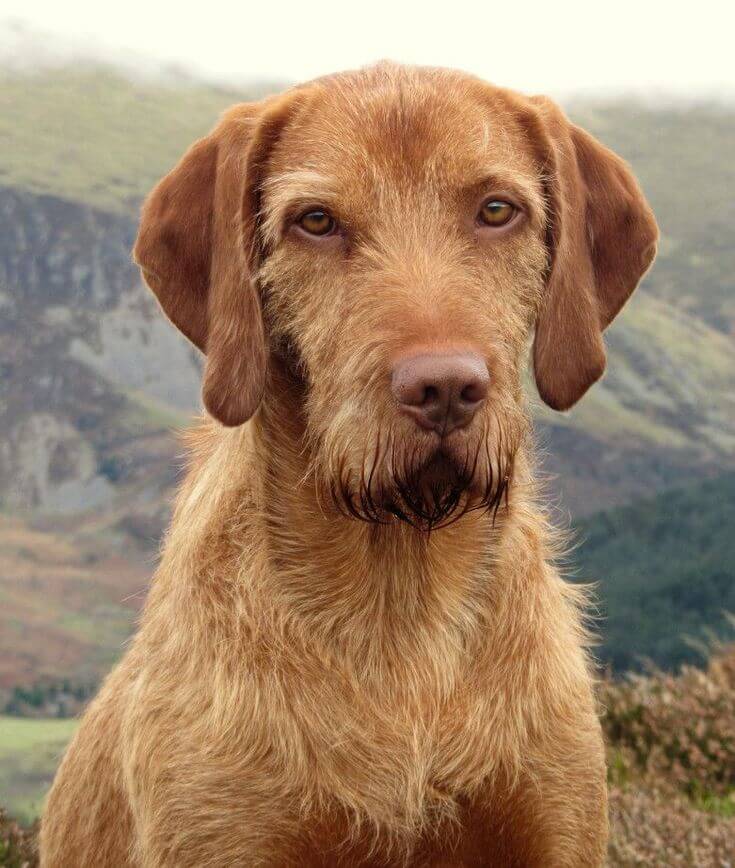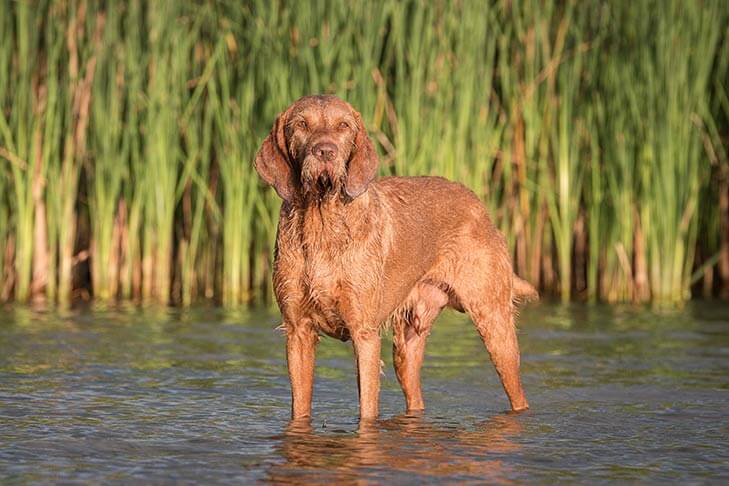Wirehaired Vizsla Dog Breed | Description, Temperament, Lifespan, & Facts
The Wirehaired Vizsla is a versatile and affectionate breed, known for its hunting prowess and loyal companionship. Originating from Hungary, this breed combines the elegance of the Vizsla with the rugged resilience of a wirehaired coat, making it suitable for various climates and terrains.
Contents
Wirehaired Vizsla Dog Breed Description

Physical Characteristics The Wirehaired Vizsla is a medium-sized dog, with males typically standing between 23 to 25 inches and females between 21.5 to 23 inches at the shoulder. They weigh around 45 to 65 pounds, with males being on the heavier side. The breed’s most distinctive feature is its dense, wiry coat, which comes in a striking golden rust color. This coat not only adds to their aesthetic appeal but also provides protection against harsh weather and rough terrain.
Coat and Colors The coat of the Wirehaired Vizsla is short, wiry, and thick, offering excellent protection. It is typically golden rust in color, giving the breed a distinctive and elegant appearance.
Size and Weight Wirehaired Vizslas are medium-sized dogs. Males are generally 23 to 25 inches tall and weigh between 55 and 65 pounds, while females stand 21.5 to 23 inches tall and weigh 45 to 55 pounds.
History and Origin
The Wirehaired Vizsla traces its roots back to the traditional smooth-coated Vizsla, a breed that dates to the 800s in Hungary. However, the Wirehaired variety was developed in the 1930s when Hungarian hunters sought a dog with a coat robust enough to withstand cold weather, icy waters, and rough terrain. Breeders crossed Vizslas with German Wirehaired Pointers to create this hardy breed. The Wirehaired Vizsla arrived in North America in the 1970s and gained recognition from the American Kennel Club in 2014.
Temperament and Personality

Wirehaired Vizslas are known for their loyal, affectionate, and gentle nature. They form strong bonds with their families and are typically good with children and other pets. This breed is highly energetic and intelligent, requiring regular physical activity and mental stimulation. Their eagerness to please and responsive nature makes them easy to train, though they do best with positive reinforcement methods.
Lifespan and Health
Average Lifespan The average lifespan of a Wirehaired Vizsla is around 12 to 14 years. With proper care, diet, and regular veterinary check-ups, these dogs can live long and healthy lives.
Common Health Issues While generally healthy, Wirehaired Vizslas are prone to certain genetic conditions, including hip and elbow dysplasia, glaucoma, progressive retinal atrophy, and cataracts. They may also suffer from hyperuricosuria, which can lead to kidney and bladder stones.
Care and Grooming
Grooming Needs Wirehaired Vizslas require minimal grooming. Their wiry coat should be brushed weekly to remove loose fur and maintain its texture. Bathing should be done as needed, typically once a month. Regular ear checks, nail trims, and dental care are also important to keep them healthy.
Bathing and Brushing A monthly bath is usually sufficient for this breed. Use a damp cloth to clean the coat between baths and a grooming mitt or brush weekly to remove loose hair. Stripping the coat once or twice a year helps remove dead fur and maintain its wiry texture.
Nail, Ear, and Dental Care Regularly trim your Wirehaired Vizsla’s nails to prevent overgrowth and discomfort. Check their ears weekly for wax buildup or debris and clean them as needed, especially after swimming. Daily brushing of their teeth is recommended to prevent dental issues.
Exercise Requirements
Wirehaired Vizslas are high-energy dogs that need at least one to two hours of exercise daily. They thrive on activities like long walks, running, hiking, and swimming. Engaging them in dog sports such as agility and dock diving can provide the mental and physical stimulation they need. Ensure they are always on a leash or in a securely fenced area, as their high prey drive can lead them to chase perceived prey.
Training Tips
Wirehaired Vizslas are eager to please and respond well to positive reinforcement training methods. Harsh corrections can cause them to shut down, so it’s important to use gentle, consistent, and positive techniques. Early socialization is crucial to expose them to various people, dogs, and environments, helping them grow into well-rounded adults.
Diet and Nutrition
Wirehaired Vizslas should be fed a high-quality, nutritionally balanced diet. It’s common to feed them two measured meals a day. Consult your vet to determine the best diet and portion sizes for your dog. Due to their high energy levels, they may require a nutrient-dense diet. Be mindful of treats and extra food to prevent overeating and obesity.
Living Conditions
Wirehaired Vizslas adapt well to various living environments, provided they receive adequate exercise and mental stimulation. They thrive in homes with yards where they can run and play. However, they can also adapt to apartment living if their exercise needs are met. They enjoy being close to their families and do best in homes where they are not left alone for long periods.
Hunting and Working Abilities
Wirehaired Vizslas are versatile hunters with a strong pointing instinct. They excel in hunting upland game birds and have a natural ability to retrieve both on land and in water. They hunt close to their handler and are known for their endurance and ability to work in various terrains. Their calm demeanor also makes them excellent companions in the field and at home.
Adoption and Buying Tips
When looking to adopt or buy a Wirehaired Vizsla, it’s important to find a reputable breeder or rescue organization. Expect to pay around $1,000 to $2,000 for a puppy from a reputable breeder. Ensure the breeder provides health clearances for both parent dogs. Adopting from a rescue group can be a rewarding experience and provides a home to a dog in need.
Fun Facts and Trivia
- The Wirehaired Vizsla was developed in the 1930s to withstand harsh Hungarian winters.
- They are known for their golden rust coat, which is unique to the breed.
- Despite their hunting prowess, they are gentle and affectionate family companions.
- The American Kennel Club recognized the Wirehaired Vizsla in 2014.
Conclusion
The Wirehaired Vizsla is a loyal, affectionate, and versatile breed that excels both as a family companion and a hunting partner. With proper care, training, and exercise, they can thrive in various living conditions and bring joy to their families for many years.
- Golden Retriever Pros and Cons: What Every Pet Parent Should Know - 15 September 2025
- Cane Corso Dog Breed: Health, Care, and Lifespan - 14 September 2025
- Catahoula Leopard Dogs: Description, Temperament, Lifespan, & Facts - 21 July 2025







